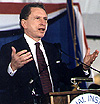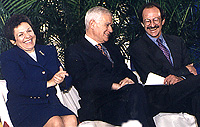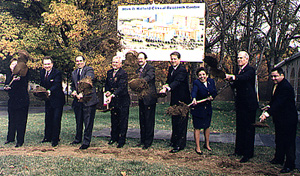Ground Broken for New Hospital
History Links
Building the Mark O. Hatfield CRC
Lasker~Bloomberg Award for Public Service (2011)
Links to Other Sources of NIH History
Medical Milestones - Clinical Center Firsts
Former Senator Mark O. Hatfield (R-Ore.), after whom the new Clinical Research Center will be named, was so thoroughly praised at the Nov. 4, 1997, groundbreaking that he said he had to pinch himself to be certain he wasn't attending his own final services. "If all of this doesn't elicit a speech, I don't know what will," he joked, admonishing NIH Director Dr. Harold Varmus to "Hurry!" and build the new hospital.

Vice President Al Gore, one of more than 500 guests and dignitaries present, called NIH "a natural habitat hospitable to medical genius," and predicted breakthroughs in the coming century in such areas as breast cancer, AIDS, Alzheimer's disease, and human genetics. He left immediately after his remarks to speak at the funeral of a close friend who had died of cancer, but said, "I will take with me the optimism that there are people living today who do not have to die of cancer, and people living today who do not have to get cancer...that is the promise of NIH."

Senator Arlen Specter (R-Pa.) had to leave early, too, but not for a funeral. He said he had to vote in the Senate and indicated that a chief concern was NIH's next budget. Specter, who inherited Hatfield's old office overlooking the Supreme Court, said he thinks Congress can substantially increase NIH's budget allocation. He joshed with Varmus about making added money available to NIH, noting that only a bureaucratic obstacle—the Office of Management and Budget—stood in the way of a bigger appropriation.
"So what if [Varmus] gets in trouble [by bypassing OMB—and the President—to make a budget request directly from a senator], as long as he gets a bigger allocation for NIH," laughed Specter, who is himself a survivor of benign meningioma and thus a beneficiary of the sort of clinical research that will be conducted in the new Clinical Research Center. He paused for comic effect and added, "I will stop now and accept your applause."

Next on the hour-long agenda were testimonials by two NIH Clinical Center patients who have benefited from research advances. They were introduced by Clinical Center Director Dr. John Gallin after Varmus had declared that "research cannot proceed without the cooperation of our patients."
Cystic fibrosis patient Charles Tolchin, 29, of Bethesda, called the CRC "a living shrine to my heroes—the NIH physicians who have demonstrated unfailing dedication, faith and infectious enthusiasm." An NIH patient since 1977, he catalogued a series of research advances that enabled him to survive in good enough shape to undergo a double-lung transplant in April of 1996. He said NIH nurses "defined compassion" and called its physicians "world class."

Coulbourne
Breast cancer survivor Jane Reese-Coulbourne said the new hospital would be the site of some of the best, and worst, days of patients' lives. For seven years she has been cancer-free after undergoing "very aggressive" treatment in a National Cancer Institute clinical trial.

Picking up on the budget thread, Representative John Porter (R-Ill.), chair of the NIH appropriation subcommittee, called for "double-funding" NIH over the next five years. "Yes, it is possible," he declared, citing an improved economy and a significant drop in the federal deficit as factors in an anticipated budget surplus. "The debate has begun on what to do with the budgetary increase," he said, recommending investments in research that make NIH "the highest national priority."
Varmus credited the next speaker, Health and Human Services Secretary Donna Shalala, with helping make the Clinical Research Center a reality by defending the project against attackers who argued that clinical research would be better practiced elsewhere than in Bethesda, and by supporting a new hospital after thorough review proved the current facility to be outmoded.
"The seeds we are planting...are about making tomorrow better than today," she said. The new facility will include both "soft beds and hard science" to achieve the healing of the human spirit. She called Hatfield "our own Moses, leading us to this mountain," and "the conscience of the Senate."

Hatfield
Hatfield, accompanied by his wife Antoinette and two of their daughters, compared pioneering scientific investigation to the Lewis and Clark Expedition (1804-1806), currently the subject of an acclaimed series on public television. "Lewis and Clark undertook their expedition without maps or modern tools, but their curiosity and tenacity...changed the world as we knew it." The same spirit of conquest is alive at NIH, he said. "This new building represents the new frontier in medical science."
He said the new Clinical Research Center won't accomplish much in isolation, but will depend on partnerships—"extensions of this building"—nationwide in the form of General Clinical Research Centers, which are NIH-funded mini-Clinical Centers.

"Tell Congress that you have found a gene, and they're interested," he counseled. "But tell Congress that you've found a way to cure a genetic disease, and watch the budget grow."
Blue eyes blazing, he said he was proud to be associated with the hope placed in the Clinical Research Center: "We all have good reasons for that hope."
—By Rich McManus (adapted from a Nov. 18, 1997, NIH Record Article)
